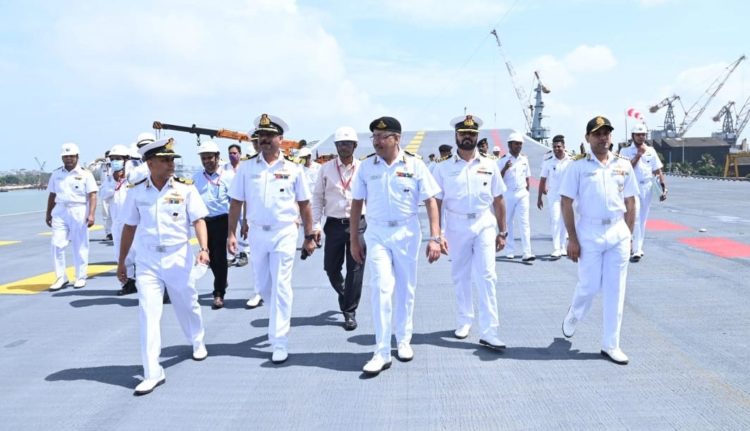New Delhi: Cochin Shipyard Limited (CSL), Kochi, on Thursday handed over the first Indigenous Aircraft Carrier (IAC-1) to the Indian Navy, which will soon be inducting the vessel to enhance its maritime security.
Designed by the Indian Navy’s Directorate of Naval Design (DND) and built by CSL, a public sector shipyard under the Ministry of Shipping (MoS), the aircraft carrier is named after India’s first aircraft carrier, the Indian Naval Ship (INS) Vikrant, which played an important role in 1971.
The 262-metre-long carrier has a full displacement of about 45,000 tonne which is much larger and more advanced than its predecessor.
The aircraft carrier is powered by four gas turbines with a total power of 88 MW and has a maximum speed of 28 knots. Manufactured at a cost of about Rs 20,000 crore under a contract between the Ministry of Defence and CSL, the project has been carried forward in three phases, ending in May 2007, December 2014 and October 2019 respectively. The ship’s keel was laid in February 2009, followed by a launch in August 2013.
With an overall indigenous content of 76 per cent, the IAC is a perfect example of the country’s quest for “Self-reliant India”, the Navy said.
With the delivery of the INS Vikrant, India has joined a select group of countries that have the capability to indigenously design and build aircraft carriers.
The INS Vikrant has been built with a high degree of automation for machinery operation, ship navigation and survivability, and has been designed to accommodate an assortment of fixed wing and rotary aircraft.
The ship will be capable of operating an air wing consisting of 30 aircraft comprising indigenously built Advanced Light Helicopters (ALH) and Light Combat Aircraft (LCA) besides MIG-29K fighter jets, Kamov-31, MH-60R multi-role helicopters.
Using a novel aircraft-operation mode known as STOBAR (Short Take-Off But Arrest Landing), the IAC is equipped with ski-jumps to launch aircraft and a series of ‘arrest wires’ for their recovery onboard.
The ship has a large number of indigenous equipment and machinery, which includes major industrial houses of the country.
Indigenisation efforts by BEL, BHEL, GRSE, Keltron, Kirloskar, Larsen & Toubro, Wartsila India, along with more than 100 MSMEs, have led to the creation of employment opportunities at local as well as pan-India level, apart from the development of ancillary industries.
Several design iterations, including the use of 3D virtual reality models and advanced engineering software, were used by the Naval Design Directorate in shaping the design of the carrier.
CSL had upgraded its shipbuilding infrastructure as well as productivity skills during the construction of the ship.
The delivery of Vikrant was marked by the signing of acceptance documents on behalf of Navy by Vikrant’s Designated Commanding Officer, representatives of Naval Headquarters and Warship Surveillance Team (Kochi), and Chairman and Managing Director on behalf of Cochin Shipyard Limited.
Vikrant has been delivered to the Indian Navy by CSL after extensive user-acceptance trials conducted between August 2021 and July 2022, during which the ship’s performance, including rudder, main propulsion, accessories, aviation facilities, weapons and sensors, along with marine maintenance and the manoeuver ability were proved to be satisfactory as per the test protocol and system parameters.
(IANS)




















